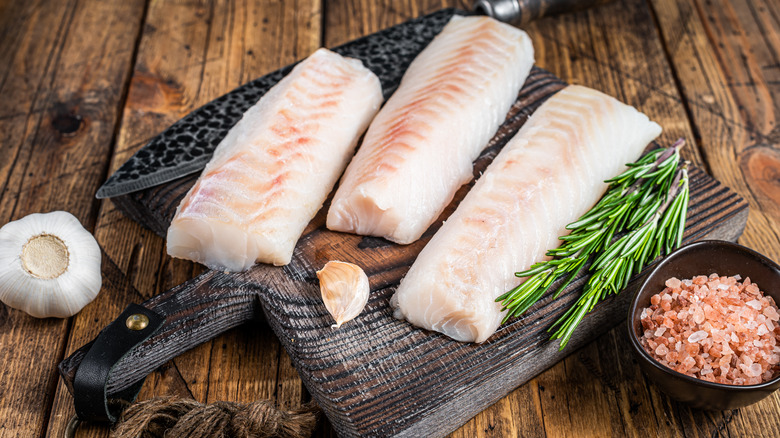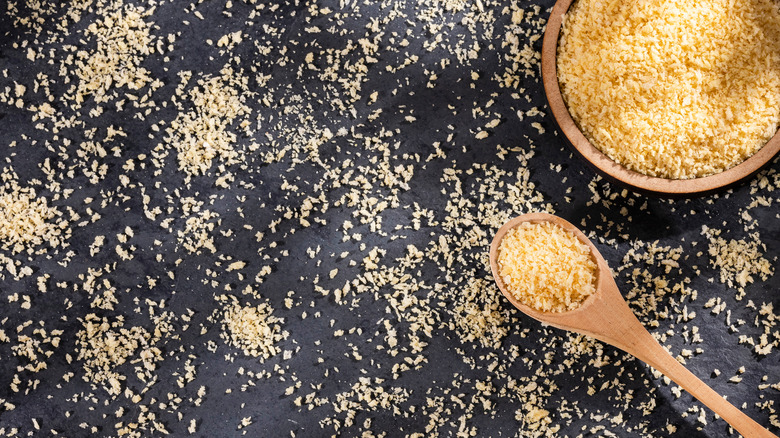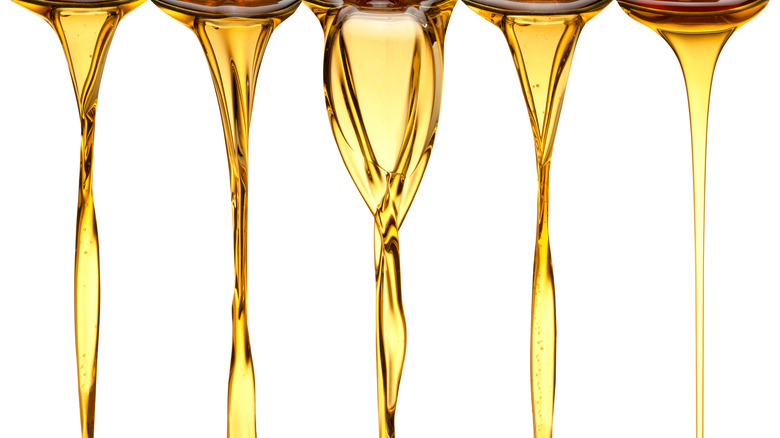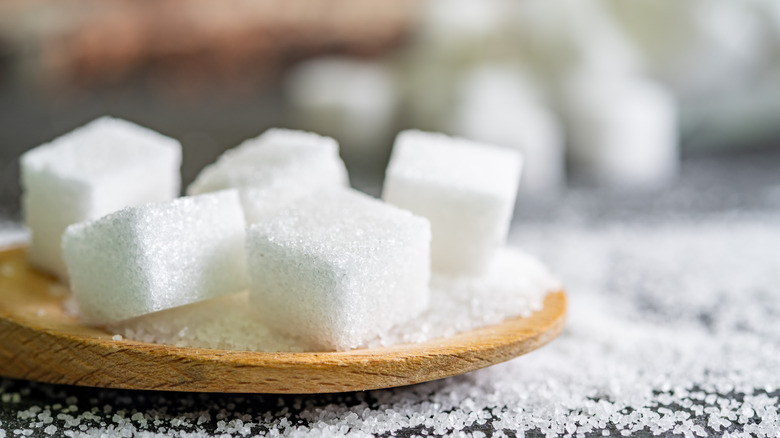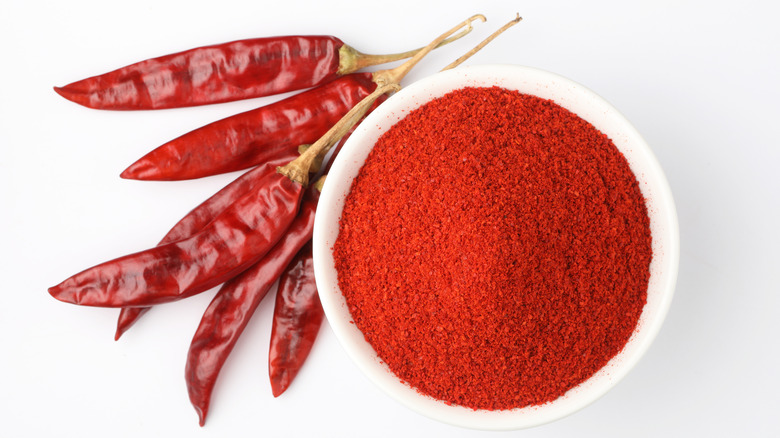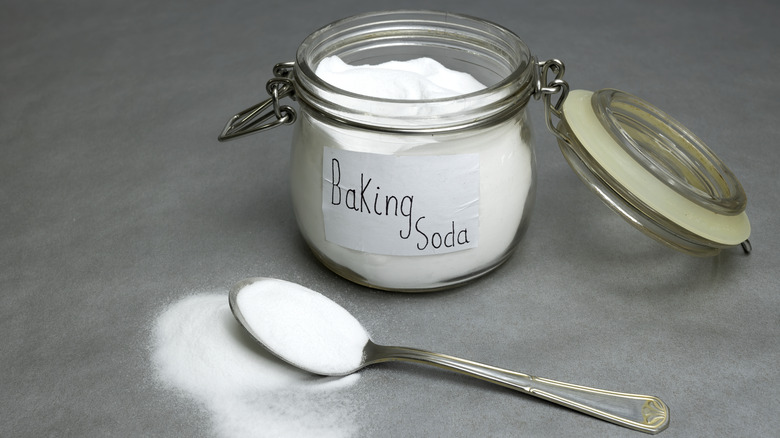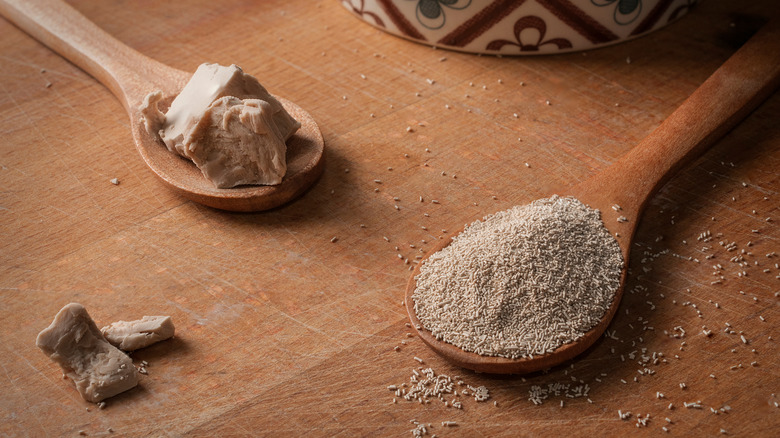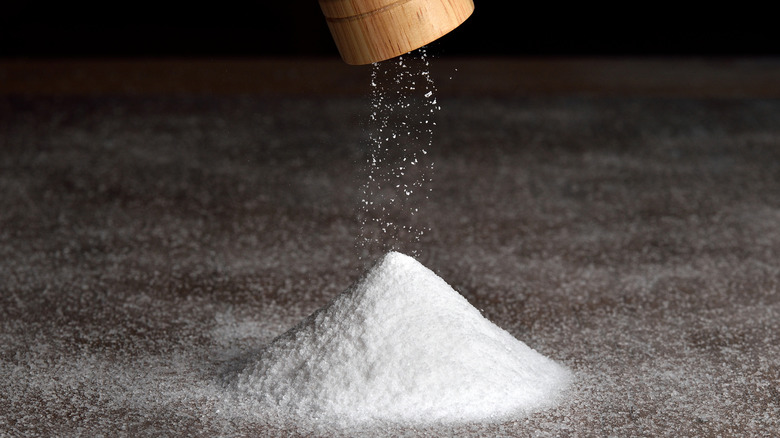What You're Really Eating When You Eat Fish Sticks
Loved by kids and adults, fish sticks, also known as fish fingers, are a convenient meal found on many family's weekly menu rotations. High in protein and containing fish as the first ingredient, it's no wonder that in 2019 their production value in the US amounted to approximately 95 million dollars, according to Statista. Plus, they're reasonably environmentally friendly: The Marine Conservation Society shared the results of a fish finger study, noting that about 85% of the fish they surveyed came from sustainable sources (via BBC).
Their popularity is quite incredible when you consider that fish sticks were originally created to solve the problem of fish overproduction, per The Smithsonian. But, not all fish sticks are created equally, and even with the best of brands, there can be dubious ingredients you'll want to look out for. From the actual fish to the breading, cooking oils, and additives, we take a look at everything you are really eating when you eat fish sticks. Spoiler alert: Unlike the results of a study by Rowse Honey which found that 20% of young adults in England think the food is made with fish's fingers, that's not actually the case (via Seafood Source).
Fish
It goes without saying that when you eat fish sticks, you are eating fish. But what kind exactly? The most common variety according to the National Oceanic and Atmospheric Administration is usually Alaskan pollock, a type of white fish the BBC deems "surprisingly sustainable." According to Consumer Reports, pollock is also among the types of fish considered to be safe for pregnant women. The Harvard School of Public Health confirms that pollock is among the varieties of fish low in mercury that you can eat up to twice a week. The outlet indicates that fish is a healthy source of omega-3 fatty acids, vitamin D, selenium, and protein.
Given their shape, it's not a surprise that it's less common to find whole fish filets in fish fingers. Instead, they are usually made from minced fish, which means that the meat goes through a bone separator, to separate it from the skin and bones. The result is more palatable, not to mention safer for children. While not as wholesome as baked whole fish, fish sticks are still high in protein and the nutritional value is similar to the unprocessed version. As far as fish stick ingredients go, the fish is the healthiest.
Breading
For most major brands, the breading used to coat the fish is made from wheat flour. In some cases (usually in more expensive products), wheat flour is replaced by panko bread crumbs. According to Japanese food aficionado Jonathan Hirshon of The Food Dictator, panko bread crumbs are crispier and airier than regular bread crumbs. They also absorb less oil, making the final result lighter. And when you bake fish sticks in the oven rather than fry them in oil, you can further reduce their fat content, and simplify the cleanup.
Gluten-free? There's a fish stick for you, too. The most commonly found gluten-free brands (including Pacific Seafood, Ian's, and Dr. Praeger's) generally use a mixture of rice and corn flour instead of wheat flour, which is a suitable alternative. In any case, none of the types of breading typically used are considered especially nutritious. However, they only form a relatively small percentage of the fish stick's contents, and unless you are gluten intolerant, they are all an acceptable option.
Refined vegetable oils
While fish has plenty of redeeming characteristics, the same cannot be said about the cheap vegetable oils commonly used to make the sticks. According to Ingredient Inspector, manufacturers typically use highly processed canola or soybean oils, which Mind Body Green notes are high in omega-6 fatty acids. While these aren't inherently bad, when consumption is far higher than omega-3 fatty acids, a host of health issues such as inflammatory diseases can ensue. In a Time Magazine article entitled "When vegetable oil isn't as healthy as you think," the outlet concludes that just like we shouldn't primarily consume bacon and butter, the same goes for vegetable oils as well.
When buying fish fingers, look for organic products to guarantee that the vegetable oils aren't made from genetically modified crops. Also, follow Iupilon's advice and opt for less processed options like rice or avocado oil instead of artery-clogging oils like canola or soybean.
Sugar and dextrose
Sugar in fish fingers? That's right. Sugar tends to make its way into many processed foods, and fish fingers are no exception. Sugar helps make food more appealing, even when it is not used in large enough quantities to be detected by our taste buds. Per Ingredient Inspector, dextrose is commonly used in fish sticks. The sweetener is usually made from corn or wheat and helps baked goods brown more easily, according to WebMD. The outlet links it to heart, kidney, and liver disease, as well as diabetes.
Not something you want to include in your regular diet? Although not every brand of fish sticks uses dextrose or sugar, most of them do. If you prefer to avoid it, the FDA requires it to be listed in the nutritional information on the side or back of the box, making it easy to skip in favor of a more wholesome product.
Spices
While fish fingers are not typically spicy (making them kid-friendly), they still contain spices such as garlic, onion, paprika, and black pepper, depending on the brand. Spices have the advantage of enhancing taste without the unhealthy side effects of some other types of flavorings.
WebMD recommends adding paprika to your diet because of its capsaicin content, a compound that provides antioxidants and can help prevent cancer, heart disease, and even gas. And, according to a 2021 study published in Advances in Experimental Medicine and Biology, paprika can also prevent the effects of obesity-related diseases. While the amount in fish sticks is minimal, regularly consuming spices is a great way to add a variety of health benefits to your diet.
To increase the positive effects of spices, consider making your own dipping sauce for fish fingers using spices like paprika, garlic, and turmeric. Or, if you decide to make your own fish sticks, experiment with adding paprika and other spices to your homemade breading.
Corn products
Rebecca Powers of The Washington Post explains that cornmeal is one of the ingredients most native to the Americas. But while corn is in fact present in many foods from fish sticks to cheap sweeteners and high-end restaurant meals, it isn't without controversy. For starters, the corn found today has definitely evolved from ancestral strains. According to Science, the popularity of genetically modified crops has caused fears for the future of heirloom corn.
Plus, eating too much corn (which is easily possible with a diet high in refined foods) can lead to a host of health problems including increased inflammation and blood sugar spikes (via Eat This, Not That!). Furthermore, the book "Corn: Chemistry and Technology," reports that a portion of the corn supply is contaminated with mycotoxins. According to the World Health Organization, these compounds can cause anything from acute poisoning to cancer. If corn is a part of your diet in moderation, look for fish stick brands that use organic corn to avoid genetically modified products.
Sodium acid phosphate and sodium bicarbonate
Not everything in fish sticks is as wholesome as fish and spices. Per Ingredient Inspector, they also contain leavening agents like sodium acid phosphate and sodium bicarbonate. Sodium bicarbonate is nothing more than good old baking soda and can be used in baking, cooking, and homemade cleaning products. But what about sodium acid phosphate?
The FDA lists sodium acid phosphate to be "generally recognized as safe," but this isn't the end of the story. MedlinePlus warns that it has laxative effects and can cause kidney damage and death. The National Kidney Foundation seconds this, explaining that it can lead to mineral imbalances and loss of kidney function. While this is the case for relatively high doses, even smaller doses can be dangerous if you have kidney issues or high blood pressure, per SF Gate. The amounts contained in fish sticks are relatively low, but there is a good chance you are consuming sodium acid phosphate from other sources. If you wish to avoid it, be sure to read the ingredients carefully.
Dairy and eggs
If you find it surprising that dairy and eggs might be present in your fish sticks, you are not alone. Fish fingers are listed among Simply Whisked's list of unexpected sources of dairy. In 2013, CBC reported that an egg allergy alert had been issued for fish stick and pie crust products in Alberta, Canada. Unfortunately, the traces of egg were not declared on the label, which the Canadian Food Inspection Agency explained was a big concern for people with severe egg allergies.
More often than not, if dairy and eggs are present in fish sticks, you will know by looking at the ingredient list. Cross-contamination should also be specified with the warning that the food was manufactured in a facility that also processes dairy and eggs. Of course, the only way to avoid them for sure if you are severely allergic is to be extra cautious and forgo fish sticks altogether.
Yeast
Yeast is another ingredient you might not know is present in fish sticks (via Ingredient Inspector). Per The Food Institute, yeast extract is commonly used in food products as a flavor enhancer, and it is considered to be safe for human consumption by the FDA. However, Dr. Sheldon Margen, professor of public health at UC Berkeley, tells the Los Angeles Times that there isn't much benefit in taking it as a supplement. She notes that "yeast is neither all good nor all bad," so while most people don't have to worry about the yeast content in food, others claim that it should be avoided.
According to Livestrong, yeast extract is rich in amino acids, vitamins, and minerals; but you'll especially notice the depth of flavor it adds to prepared foods. Since yeast is a natural product — a characteristic that consumers are increasingly seeking out — Future Market Insights anticipates that sales of yeast extract are expected to double by 2031.
Sodium
Anyone who has suffered from high blood pressure knows that sodium intake needs to be regulated to prevent health side effects. In fact, a 2020 study published in the International Journal of Molecular Science determined that too much sodium can cause hypertension, chronic kidney disease, stroke, and cardiovascular diseases. Additionally, a 2020 study published by the Current Hypertension Report found that dietary salt is linked to higher blood pressure. The report goes on to specify that this will depend on the individual, but with or without hypertension, salt is still potentially unhealthy.
Unfortunately, fish sticks are high in sodium. In fact, according to Eat This Much, some brands provide more than a quarter of the recommended amount of sodium in just one serving. According to the CDC, dietary sodium should not exceed 2,300 mg, so look for brands with low salt content or consider eating less than a full serving and supplementing your meal with homemade sides where the salt content can be controlled.
Natural flavors
If you eat processed foods, you are likely consuming added natural flavors. But are they really natural? According to the FDA, natural flavor "contains the flavoring constituents derived from a spice, fruit or fruit juice, vegetable or vegetable juice, edible yeast, herb, bark, bud, root, leaf or similar plant material, meat, seafood, poultry, eggs, dairy products, or fermentation products thereof, whose significant function in food is flavoring rather than nutritional." So far, so good.
However, Gwendolyn Wyard, the Organic Trade Association's vice president of regulatory and technical affairs, argues that since non-organic natural flavors can still use preservatives and solvents, the consumption of organic foods is recommended due to its stricter regulations (via The New York Times). If you wish to avoid natural flavors, simply look at the ingredients on the packaging. Natural flavors are required to be listed per the FDA, so you can choose for yourself whether or not to avoid them.

